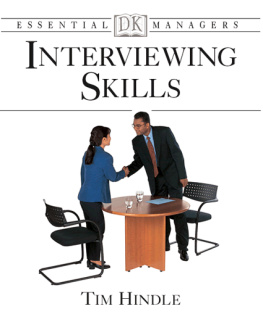Successful Interviewing: Techniques for Hiring, Coaching, and Performance Management Meetings

Successful Interviewing: Techniques for Hiring, Coaching, and Performance Management Meetings
Diane Arthur

2000 American Management Association. All rights reserved. This material may not be reproduced, stored in a retrieval system, or transmitted in whole or in part, in any form or by any means, electronic, mechanical photocopying, recording, or otherwise, without the prior written permission of the publisher.
Printed in the United States of America
Contents
About This Course
Say the word interview to most managers and they are likely to respond that interviewing is the responsibility of human resources professionals or, at best, that it should be a combined effort between human resources and managers. Pressed further, they will explain that it is not their job to interview. They are managersnot interviewers.
In reality, managers as well as HR practitioners conduct interviews throughout their business day. On any given day, you, as a manager, are making interview-based decisions about whom to hire, promote, fire, discipline, or terminate. It is likely that you also call on interviewing strategies to accomplish your business objectives. Whether a manager or an HR practitioner, you need to understand how to conduct the various types of interviews in a correct and maximally effective way.
The two primary goals for this course are to present typical business interview situations and to teach the skills needed to achieve success in each situation. The course guides you reassuringly through the process of 12 different types of interviews. Here you will learn the value of planning and preparing for the interview, including how to build rapport and to structure your environment and your time. By following this course, you will develop valuable techniques to get the most out of each interview, using active listening, careful questioning, and an understanding of body language. Essential information on documentation and legal issues offers solid and timely guidance to safeguard even the most inexperienced interviewer. The course incorporates current thinking on competency-based interviewing and numerous application exercises you can translate to your own interview experience. Throughout, you will be able to identify with the real-world scenarios illustrating the right and the wrong way to conduct an interview. Whether you are an HR practitioner or a manager, mastering the skills and strategies presented in Successful Interviewing: Techniques for Hiring Coaching, and Performance Management Meetings will prepare you to be a more confident, productive, and effective interviewer.
Diane Arthur is president of Arthur Associates Management Consultants, Ltd., a human resources development firm based in Northport, New York. She has more than 25 years of human resources experience as a consultant, workshop leader, and lecturer, covering all facets of human resources, including interviewing skills; equal employment opportunity; HR policies and procedures; employee handbooks; position analysis; job descriptions; performance appraisal systems; employer/employee relations; disciplinary/grievance proceedings; orientation programs; training and development needs assessments; communication skills; career planning; coaching and counseling. Arthur consults for a wide range of companies, including large corporations, nonprofit organizations, and the healthcare industry. Arthur is the author of numerous works dealing with human resources and general management. She has written many books for AMACOM, including The Complete Human Resources Writing Guide, three editions of Recruiting, Interviewing, Selecting & Orienting New Employees, and two editions of Managing Human Resources in Small and Mid-Sized Companies, as well as articles for various publications, including the National Business Employment Weekly, Personnel, Management Solutions, Supervisory Management, and HR Focus. Arthur is a highly rated AMA workshop leader and is listed in the 26th edition of Whos Who in the East.
The publisher would like to thank the following people for their review of the manuscript of this course: Paul Falcone, Director of Employment and Development, Paramount Pictures, Hollywood, California, and Robert Lucas, President of Creative Presentations Resources, Inc., Casselberry, Florida.
How to Take This Course
This course consists of text material for you to read and three types of activities (the pre- and post-test, in-text exercises, and end-of-chapter review questions) for you to complete. These activities are designed to reinforce the concepts introduced in the text portion of the course and to enable you to evaluate your progress.
PRE- AND POST-TESTS
Both a pre-test and post-test are included in this course. Take the pre-test before you study any of the course material to determine your existing knowledge of the subject matter. Submit one of the scannable answer forms enclosed with this course for grading. On return of the graded pre-test, complete the course material. Take the post-test after you have completed all the course material. By comparing results of the pre-test and the post-test, you can measure how effective the course has been for you.
To have your pre-test and post-test graded, please mail your answer forms to:
Educational Services
American Management Association
P.O. Box 133
Florida, NY 10921
All tests are reviewed thoroughly by our instructors and will be returned to you promptly.
.
THE TEXT
The most important component of this course is the text, where the concepts and methods are presented. Reading each chapter twice will increase the likelihood of your understanding the text fully.
We recommend that you work on this course in a systematic way. Reading the text and working through the exercises at a regular and steady pace will help ensure that you get the most out of this course and retain what you have learned.
In your first reading, concentrate on getting an overview of the chapter content. Read the learning objectives at the beginning of the chapter first. They will act as guidelines to the major topics of the chapter and identify the skills you should master as you study the text. As you read the chapter, pay attention to the headings and subheadings. Find the general theme of each section and see how that theme relates to others. Dont let yourself get bogged down with details during the first reading; simply concentrate on understanding and remembering the major themes.
In your second reading, look for the details that underlie the themes. Read the entire chapter carefully and methodically, underlining key points, working out the details of examples, and making marginal notes as you go. Complete the activities.
ACTIVITIES
Interspersed with the text of each chapter you will find a series of activities. These can take a variety of forms, including essays, short-answer quizzes, or charts and questionnaires. Completing the activities will enable you to try out new ideas, practice and improve new skills, and test your understanding of the course content.
Next page








